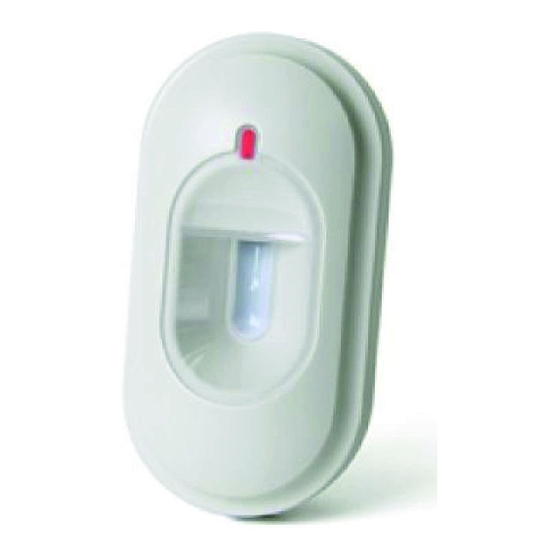Table of Contents
Advertisement
Quick Links
TOWER 40
Wireless PowerCode Digital Mirror PIR Detector
1. INTRODUCTION
The TOWER 40 is a microprocessor-controlled wireless digital PIR
detector, designed for easy installation, free of vertical adjustment.
It features parabolic and cylindrical mirrors with uniform detection
sensitivity throughout its operating range, up to 18 meters (59 ft),
with creep zone protection.
The advanced True Motion Recognition™ algorithm (patented)
allows the TOWER 40 to distinguish between true motion of an
intruder and any other disturbances which may cause false alarms.
An on-board motion event jumper determines whether 1 or 2
consecutive motion events trigger an alarm.
The TOWER 40 includes the following features:
• Incorporating patent pending black mirrors for extremely high
white light immunity.
• Advanced elliptical / parabolic mirror technology (patent
pending).
• Provides multiple curtain coverage (patent pending).
• V-slot® optic technology (patent pending) for improved
robustness, anti-vandalism and for very high reliability.
• The entire electronic circuit is enclosed in the front cover with
the optics. The sensor element is isolated from gusts of wind
and insects.
2. SPECIFICATIONS
Detector Type: Dual element low-
noise pyroelectric sensor.
OPTICAL (see Figure 2)
Mirror Data:
No. of Beam Elements:
18x3=54 far parabolic mirror
segments.
No. of Curtain elements: 18
Max. Coverage: 18 m (59 ft) / 90°
White Light Immunity: Above
20000 lux
ELECTRICAL
Internal
Battery:
3V
Lithium
battery, type CR-123A. For UL
installations,
use
Panasonic
Sanyo only (EN50131-6 type C).
Nominal Battery Capacity:
1400 mA/h.
Battery Life (with LED on):
Typically over 3 years.
Battery Power Test: Performed immediately upon battery
insertion and periodically after every several hours.
FUNCTIONAL
True Motion Event Verification: 2 position selector - 1 (OFF) or
2 (ON) motion events.
Visual Indications:
LED Lights for about 3 seconds upon transmission of alarm &
tamper messages and upon motion detection in the walk test
mode.
LED Flashes during the power-up stabilization period, or after
restoring (pressing) the tamper switch.
LED does not light upon transmission of supervision
messages.
D-300430
12m (39ft)
TOP VIEW
90°
6m (19ft)
3m (10ft)
0
3m (10ft)
6m (19ft)
12m (39ft)
0
3
6
12
10 19
39
SIDE VIEW
2.4 m
or
(8 ft)
0
3
6
12
10 19
39
Figure 2. Coverage Pattern
• Creep zone protection.
• Back tamper switch to prevent
unauthorized removal from wall.
• Incorporates a fully supervised
PowerCode transmitter.
• Sophisticated frequency domain
digital signal processing.
• No vertical adjustment is needed.
• Battery compartment for easy
battery
replacement
access to the electronic circuit.
• Programmable
counter.
• Specially constructed against
vandalism.
• Very low current consumption
• Sealed chamber protects the optical system.
• Tamper switch for detector opening / removal alert.
• Improved white light protection.
• Elegantly styled, sturdy case.
Rearm Timer: Rearms the detector 2 minutes after the last motion
detection. The detector reverts to the initial state if there is no
movement during 2 minutes. The timer is disabled in the walk test
mode.
WIRELESS
Frequency (MHz): 315 (U.S. version), 433.92, 868.95, 869.2625
or other frequency according to local requirements.
Transmission Sequence: 3 data bursts at variable / random
intervals within 3 seconds.
Encoding: Over 16 million possible combinations.
Total Message Length: 36 bits.
Supervision Message: Signaling at 60-minute intervals (U.S.
18m
59ft
version) or 15 minute intervals (UK version), or according to the
local standards.
MOUNTING
Height: 1.8 - 2.4 m (6 - 8 ft).
18m
Installation Options: Surface or corner.
59ft
ENVIRONMENTAL
RFI Protection: >10 V/m up to 2000 MHz.
Operating Temperatures: -10
Storage Temperatures: -20
Compliance with Standards: Designed to meet FCC Part 15
and Directive 1999/5/EC of the European Parliament.
EN 50131-2, Grade 2, Class II. IC: RSS-210.
PHYSICAL
Size (H x W x D): 122 x 63 x 42 mm (4-13/16 x 2-1/2 x 1-11/16").
Weight (with battery): 114 g (4 oz).
Color: White.
PATENTS
U.S. Patents 5,693,943
Installation Instructions
(1)
(2)
without
motion
event
1. LED
2. Mirror
Figure 1. General View
C to 50
C (14
F to 122
°
°
°
°
C to 60
°
C (-4
°
F to 140
6,818,881 (other patents pending).
F).
°
°
F).
1
Advertisement
Table of Contents

Summary of Contents for Visonic TOWER 40
- Page 1 PowerCode transmitter. The advanced True Motion Recognition™ algorithm (patented) • Sophisticated frequency domain allows the TOWER 40 to distinguish between true motion of an digital signal processing. intruder and any other disturbances which may cause false alarms. • No vertical adjustment is needed.
- Page 2 3. INSTALLATION 3.1 General Guidelines C. Jumpers Settings Set event count jumper and LED jumper as required, as Do Not Install in the Following Locations: described in the following illustration: ON: LED ENABLED Figure 5 - Jumpers Settings LED Functions Summary After battery insertion and rear cover closure, the LED flashes for 2 minutes approximately until the detector stabilizes.
- Page 3 4.1 Product Limitations The digital circuit of this device has been tested and found to Visonic Ltd. wireless systems are very reliable and are tested to comply with the limits for a Class B digital device, pursuant to high standards. However, due to their low transmitting power and Part 15 of the FCC Rules.
- Page 4 VISONIC LTD. (ISRAEL): P.O.B 22020 TEL-AVIV 61220 ISRAEL. PHONE: (972-3) 645-6789, FAX: (972-3) 645-6788 VISONIC INC. (U.S.A.): 65 WEST DUDLEY TOWN ROAD, BLOOMFIELD CT. 06002-1376. PHONE: (860) 243-0833, (800) 223-0020 FAX: (860) 242-8094 VISONIC LTD. (UK): FRASER ROAD, PRIORY BUSINESS PARK, BEDFORD MK44 3WH. PHONE: (0870) 730-0800 FAX: (0870) 730-0801 www.visonic.com...















Need help?
Do you have a question about the TOWER 40 and is the answer not in the manual?
Questions and answers